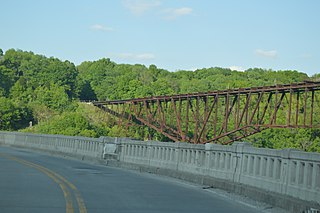
Kentucky, officially the Commonwealth of Kentucky, is a landlocked state in the Southeastern region of the United States. It borders Illinois, Indiana, and Ohio to the north, West Virginia to the northeast, Virginia to the east, Tennessee to the south, and Missouri to the west. Its northern border is defined by the Ohio River. Its capital is Frankfort and its most populous city is Louisville. As of 2020, the state's population was approximately 4.5 million.

John Cabell Breckinridge was an American lawyer, politician, and soldier. He represented Kentucky in both houses of Congress and became the 14th and youngest-ever vice president of the United States. Serving from 1857 to 1861, he took office at the age of 36. He was a member of the Democratic Party, and ran for president in 1860 as a Southern Democrat. He served in the U.S. Senate during the outbreak of the American Civil War, but was expelled after joining the Confederate Army. He was appointed Confederate Secretary of War in 1865.

Maysville is a home rule-class city in Mason County, Kentucky, United States, and is the seat of Mason County. The population was 8,873 as of the 2020 census. Maysville is on the Ohio River, 66 miles (106 km) northeast of Lexington. It is the principal city of the Maysville Micropolitan Statistical Area, which comprises Mason County. Two bridges cross the Ohio from Maysville to Aberdeen, Ohio: the Simon Kenton Memorial Bridge built in 1931 and the William H. Harsha Bridge built in 2001.
The Maysville Road veto occurred on May 27, 1830, when United States President Andrew Jackson vetoed a bill that would allow the federal government to purchase stock in the Maysville, Washington, Paris, and Lexington Turnpike Road Company, which had been organized to construct a road linking Lexington, Kentucky, to Maysville on the Ohio River, the entirety of which would be in the state of Kentucky. Its advocates regarded it as a part of the national Cumberland Road system. Congress passed a bill in 1830 providing federal funds to complete the project. Jackson vetoed the bill on the grounds that federal funding of intrastate projects of this nature was unconstitutional. He declared that such bills violated the principle that the federal government should not be involved in local economic affairs. Jackson also pointed out that funding for these kinds of projects interfered with paying off the national debt.

Morgan's Raid was a diversionary incursion by Confederate cavalry into the Union states of Indiana, Kentucky, Ohio, and West Virginia during the American Civil War. The raid took place from June 11 to July 26, 1863. It is named for the commander of the Confederate troops, Brigadier General John Hunt Morgan. Although it caused temporary alarm in the North, the raid failed.

The Kentucky Community and Technical College System (KCTCS) is the system of public community and technical colleges in the U.S. state of Kentucky. It is headquartered in Versailles, Kentucky, and has 16 colleges with over 70 campuses. Programs offered include associate degrees; pre-baccalaureate education to transfer to a public 4-year institution; adult education, continuing and developmental education; customized training for business and industry; and distance learning. KCTCS was founded as part of the Postsecondary Improvement Act of 1997, signed by former Kentucky Governor Paul E. Patton, to create a new institution to replace the University of Kentucky's Community College System and the Kentucky Department of Education's network of technical schools. The Kentucky Fire Commission, a separate state entity responsible for training emergency responders, also became part of KCTCS at that time.

Area code 606 is a telephone area code serving the eastern half of south-central and all of the eastern part of the Commonwealth of Kentucky. Cities and towns in the area code include Ashland, Morehead, Hazard, Middlesboro, Somerset, Stanford, London, Corbin, Greenup, Paintsville, Pikeville and Maysville. Most of its service area lies within the Kentucky region known as the Eastern Kentucky Coalfield. It runs along the entire length of the state's borders with Virginia and West Virginia.

Kentucky Route 11 (KY 11) is an American highway maintained by the Kentucky Transportation Cabinet that runs from Maysville to Barbourville. The route from Maysville to Mount Sterling is being upgraded on a new alignment as part of a "macro-corridor" within the state of Kentucky.
Washington is a neighborhood of the city of Maysville located near the Ohio River in Mason County in the U.S. state of Kentucky. It is one of the earliest settlements in Kentucky and also one of the earliest American settlements west of the Appalachian Mountains. It played a significant role in the lead-up to the Civil War, producing two civil war generals and an escaped slave whose legal case established Canada as a safe haven for escaping slaves. It also provided the site where Harriet Beecher Stowe witnessed a slave auction. It has since been annexed by Maysville, and is sometimes now referred to as Old Washington. The community is in Area 606 served by the 759 exchange.

U.S. Route 62 (US 62) in Kentucky runs for a total of 391.207 miles (629.587 km) across 20 counties in western, north-central, and northeastern Kentucky. It enters the state by crossing the Ohio River near Wickliffe, then begins heading eastward at Bardwell, and traversing several cities and towns across the state up to Maysville, where it crosses the Ohio River a second time to enter the state of Ohio.

Phillips' Folly is an historic three-story brick residence in Maysville, Kentucky. The home's Antebellum architecture displays a blend of styles which may be explained, in part, by the home's speculative six-year construction period, which ended with its completion in 1831. The Sutton Street entrances are Federal, windows are typical Greek Revival in their size and character, and the two-tiered portico and the segmental dormers reflect a Georgian influence. The portico and Doric frieze are similar to Drayton Hall (1738–42) near Charleston, South Carolina. The stepped parapets on the end walls are peculiar to the Ohio River Valley and are "associated with the 'Dutch' character of Cincinnati, Ohio and the surrounding area." The home also possesses an artful and unique dry stacked foundation that is set without mortar. Phillips' Folly was added to the National Register of Historic Places on August 10, 1978. Phillips' Folly is a private residence.
Mays Lick(a.k.a.Mayslick, originally known asMay's Lick) is a census-designated place and unincorporated community in Mason County, Kentucky, United States. As of the 2020 census, it had a population of 252.
The following is a timeline of the history of Lexington, Kentucky, United States.

Young's High Bridge is a former railroad bridge near Tyrone, Kentucky, USA, that spans the Kentucky River between Anderson County, Kentucky and Woodford County, Kentucky for the Louisville Southern Railroad. The cantilever bridge, named in honor of William Bennett Henderson Young, was constructed in 1889, and the first train crossed over on August 24, 1889. The bridge is 1,659 feet in length, is 283 feet above the river, and includes a 551 foot long cantilever span.
The Maysville and Lexington Railroad was a 19th-century railway company in Kentucky in the United States, connecting Maysville on the Ohio River with Lexington at the center of the state. It operated from 1850 to 1856, when it failed. It was subsequently re-established as two separate companies – a Northern and a Southern division, in 1868. Both were eventually incorporated into the L&N and today make up part of the CSX Transportation system.
The Maysville and Lexington Railroad, North Division, was a 19th- and early 20th-century railway company in north-central Kentucky in the United States. It operated from 1876, when it reëstablished service on the routes of its failed predecessor, the Northern Division, until 1921, when it was purchased along with the Southern Division by the L&N.

The Cincinnati metropolitan area is a metropolitan area with its core in Ohio and Kentucky. Its largest city is Cincinnati and includes surrounding counties in the U.S. states of Ohio, Kentucky, and Indiana.
The CC Subdivision is a railroad line owned by CSX Transportation in the U.S. State of Kentucky. The line runs from Taylor Mill, Kentucky, to Corbin, Kentucky, for a total of 177.1 miles (285.0 km). At its north end the line continues as a branch of the Cincinnati Terminal Subdivision, and at its south end it continues as the KD Subdivision of the Atlanta Division.










